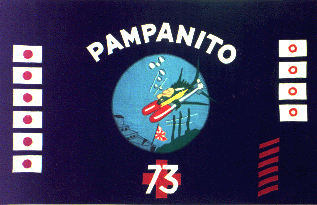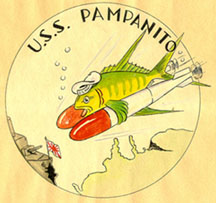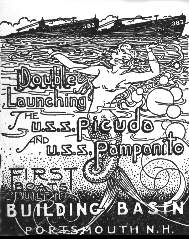HISTORY AND CREW OF USS PAMPANITO (SS-383) USS Pampanito was built at the Portsmouth Naval Shipyard, New Hampshire as part of an expanded wartime production effort. She and USS Picuda (SS-382) were the first two of ten subs to be built in Portsmouth's new building basin. Later, to meet the increased demands of the war, submarines were assembled in the dry docks which were normally used to repair vessels. Pampanito's keel was laid down on March 15, 1943 and she was launched the following July 12 in a double ceremony honoring the first two subs to be floated out of the new construction basin. Following launching, work continued fitting her out and on November 6, 1943 Pampanito was commissioned to officially became part of the U.S. Fleet.
Although the crew was new to Pampanito, there were many experienced submariners aboard to train and qualify the new hands. Commanding Officer Lt. Commander Charles Jackson, Jr., for example, came from USS Spearfish (SS-190), and Executive Officer Paul E. Summers had been assigned to Pampanito following seven war patrols on USS Stingray (SS-186). On January 15, 1944 Pampanito left New London to sail for the Pacific Ocean to join up with the war. Pampanito sailed south traversing the Panama Canal on January 24, 1944 where she spent four days in Balboa for minor repairs and tests. Upon arriving in Pearl Harbor, on Valentine's Day, she was laid up for a week for further repairs and installations, including a five day drydocking to renew and repair her wooden (lignum vitae) shaft bearings. While in Hawaii, on March 6, 1944, Charles Jackson was relieved of command, and Summers was fleeted up to Commanding Officer. Officers and crew were prepared as much as possible for the dangerous job that lay ahead. Day and night drills were conducted in the warm waters around Hawaii where practice torpedoes were fired, gun crews drilled, and many test dives were made. Pampanito even received an indoctrination depth charging. Pampanito returned to Pearl Harbor where she was loaded with fuel and provisions. Sixteen Mark 14 steam torpedoes were loaded into the forward torpedo room, and eight Mark 18 electric torpedoes were loaded into the after room. On March 15, 1944, exactly one year after her keel was laid down at Portsmouth, Pampanito left on her first patrol.
Below are the accounts of Pampanito's war patrols. The material
for these patrol histories was gathered from a variety of sources, including
the war patrol reports of Pampanito and all the ships she operated
with, oral histories of crew and survivors gathered by Association staff,
and several published works. The events of the third patrol were largely
unraveled by Joan and Clay Blair for their book Return From the River
Kwai. This book is a remarkable combination of oral histories and official
records that describes every aspect of these events. Clay Blair is also
the author of Silent Victory, the definitive history of U.S. submarine
operations during the war. Other books about Pampanito's history are: Historic Photographs
POW Survivor Tales and Robert Bennet Diary Sinking a Gallant President, 3rd War Patrol, Carmody Rescue of Prison Ship Survivors, 3rd War Patrol, Davis Fear of the Cobra, Hurricane during 4th War Patrol, Carmody Second Chances: From Torpedoes and Bombs, Carmody Japan Party, Rangoon, March 1944, A Story Of Survival, Carmody
Intercepted Imperial Japanese Navy messages, messages.pdf (3.6 meg PDF) Intelligence on Imperial Japanese treatment of POWs nara-powdoc.pdf (2.8 meg PDF) Rescue 16 mm Film POWs Rescued by Pampanito Post War HistoryPampanito's Wartime CrewU.S. Submarine Losses
|

 After
commissioning, Pampanito's crew spent from November 29, 1943 to
January 15, 1944 conducting sea trials and training exercises in the icy
waters off Portsmouth and New London, Connecticut. Practice attack approaches
were made and exercise torpedoes were fired. All of the deck guns were
fired and equipment was calibrated. A six day practice war patrol was also
carried out.
After
commissioning, Pampanito's crew spent from November 29, 1943 to
January 15, 1944 conducting sea trials and training exercises in the icy
waters off Portsmouth and New London, Connecticut. Practice attack approaches
were made and exercise torpedoes were fired. All of the deck guns were
fired and equipment was calibrated. A six day practice war patrol was also
carried out.